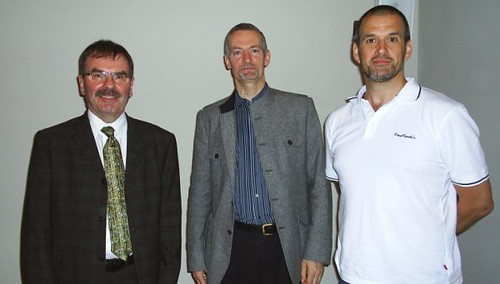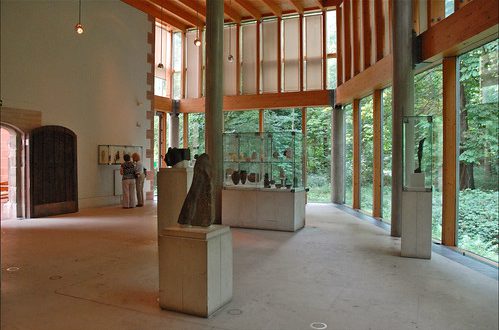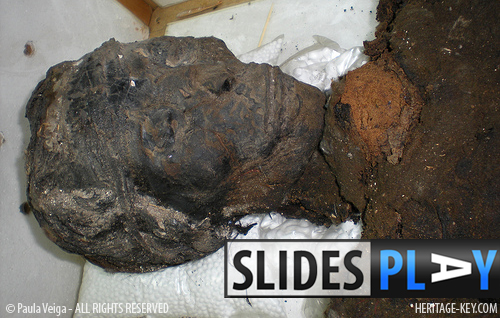Today was the first day of the CRE XI conference, but last night we had a lecture by Prof. Demarée of Leiden University. Demarée, who studied Egyptology in Leiden, Copenhagen and Oxford and has a PhD on “Ancestor Worship in Ancient Egypt”, spoke about a group of papyri fragments scattered in different museums that, together with some ostraca and graffiti, provide researchers more information on the workers’ community at Deir Al-Medina, especially from the Ramesside Period and the second half of the New Kingdom.
“Now, thanks to a largely unpublished dossier of texts, we are gradually beginning to understand what happened to them,” he said.
He showed the audience the originals, which are written in hieratic, and some translations into hieroglyphic that he’d done, and established the relationship between the fragments and their contents.
This was done at the main entrance of the Rijksmuseum of Leiden, with the magnificent Temple of Taffeh behind him – a gift to the Netherlands from the Egyptian antiquities in the 1960’s.
This Roman Period temple is dated from 1-14 AD and it was part of the Roman fortress known as Taphis. It came to Leiden in 1971, as a result of the construction of the Great Dam of Aswan and the consequent threat posed to several monuments and archeological sites in Nubia. This building is constructed from 657 blocks weighing approximately 250 tons. After arriving in 1971, it was reconstructed in a new wing of the Rijksmuseum van Oudheden.
Highlights of Day One
The speakers and guests attending CRE XI had the opportunity to visit the museum exhibitions for free after hours, including the temporary ‘Gustave Flaubert’s Egypt’ (Het Egypte van Gustave Flaubert), and it was a must for us researchers, as we could appreciate and photograph the pieces without the public present. Drinks followed. Also a must.
Today, which was the first day of presentations, we had some interesting subjects; Nathalie Andrews from Durham University compared the ‘two eyes’ in the role of the sacred eye in ancient Egyptian religion.
In Chapter 17 from the Papyrus of Ani, the Book of The Dead, several quotes enhance this similarity. She compared the references to the ‘Eye’ both in the myth of the destruction of mankind and the battle between Horus and Seth. She said ‘the two myths are woven together’ and she deconstructed the several items showing the ‘path’ the Eye has to make to re-establish order. This was crucial in ancient Egypt.
There was no mention of Dan Brown’s circumpunct and it’s relation to the symbol Ra!
Antonio Morales from Pennsylvania University analyzed priestly texts about the goddess Nut from the Old Kingdom into the Middle Kingdom. The spells are usually read on the inside of the coffin lid, to protect the deceased. Jens Blach Jorgensen spoke about the union of Re and Osiris in two types of religious discourse. He stated that god is fixed and distant from this world, he only has a symbolic presence and events are narrated in the past but that time is cyclical in ancient Egypt. A bit confusing and intricate but nevertheless, more inputs about Egyptian gods are always welcome.
Later in the afternoon, in the cross-cultural session, Alexandros Giannakoulas from Oxford University presented a very controversial inconclusive theory about what we know as milk jars and which he called parturient vessels, trying to pinpoint medical products from Egypt in Greek soil.
Since many people were not able to come to the conference due to bad weather conditions, lack of funding and other pressing issues, the session and the day finished with Felix Hoflmayer from the DAI in Berlin and Oman which is attempting a very interesting technique to radiocarbon date pottery from the Aegean and from Egypt.
He explained to me on the day before how carbon dating tests are done (I already had some hints from the biomedical techniques learned at Manchester), and how 20 year margins of error are used when dating objects from 1700 BC. A branch of olive was found crystallized in pumice from a volcano eruption in Santorini around 1600 BC and this was targeted to be a key point to the next steps of his investigation. He is going to take samples from closed contexts and compare those with the evidence at the oxford project for carbon dating, trying to establish new links between pottery types and historical chronology.
All in all, a fascinating collection of talks – spiced up with a milk jug of controversy.
I’m going to stay at CRE XI till the end, and my own session – on Green Osiris – is tomorrow, so stay tuned to Heritage Key to find out what’s coming next, and to hear more about the talks mentioned here!





